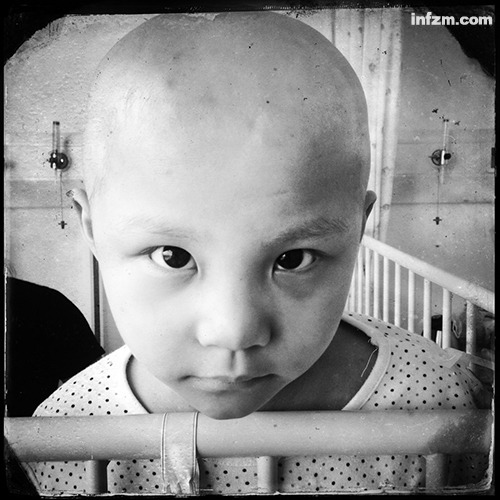Children under the claw of malignant tumors
- By Wu Jin
 0 Comment(s)
0 Comment(s) Print
Print E-mail China.org.cn, October 19, 2014
E-mail China.org.cn, October 19, 2014
Looking out at the ground through a bay window on the 15th floor of Tianjin Tumor Hospital, Yang Yali held her six-year-old daughter, Xin Jie, tightly in her arms.
 |
|
Children under the claw of malignant tumors |
"Life is too miserable, why don't we jump from here?" Yang asked her daughter.
"Mum, I don't want to die, I want to live," Her bald, emaciated daughter responded.
Xin has received chemotherapy at the hospital for malignant tumors growing in her body. The treatment has had a great impact on her, causing her to be unable to eat and drink for eight consecutive days.
After Xin was diagnosed with cancer and hospitalized, her parents quit their jobs to tend to her day and night. Life becomes very difficult for families whose children have been diagnosed with cancer, who need around-the-clock care and substantial financial support.
"Every child with cancer has a long story to tell," said Yang.
According to the World Health Organization, malignant cancers – including leukemia, tumors of the central nervous system and other solid tumors – have become the second-largest cause of mortality in children after accidental injuries. In China, the morbidity rate of cancers among urban children rose 18.8 percent in five years from 20.8 per 100,000 in 2003 to 24.7 per 100,000 in 2008.
"The number of patients has been increasing rapidly in recent years, and the 32 beds in our department would be far from being enough even if they were doubled," said Sun Xiaofei, a doctor specializing in pediatric cancer at Guangzhou Tumor Hospital, part of Sun Yat-sen University.
Unlike tumors that occur in adolescents, tumors that appear in young children grow faster, developing from early stage to late stage within an average of three months. Timely diagnosis is therefore pivotal in saving the lives of children with cancer.
Six years ago, when the melamine scandal swept the dairy industry in China, children put at risk by the tainted milk power received type-B ultrasonic scans free of charge, which saved the lives of a number of children with early stage malignant tumors.
"That year, we diagnosed nine cases of nervous system tumors with mother cells in an early stage, and the treatments for those patients turned out well," said Yan Jie, a doctor specializing in pediatric tumors at Tianjin Tumor Hospital. "But now most patients come to us at a later stage."
Although there is a large demand for care for patients with pediatric tumors, Tianjin Tumor Hospital and Guangzhou Tumor Hospital of Sun Yat-sen University are the only two hospitals in China to open departments exclusively designated to treat pediatric cancers.
In numerous cases, precious time has slipped away when children were transferred to another hospital, since many hospitals cannot provide both diagnosis and chemo- or radiotherapies.
Children are very sensitive to chemotherapy, and their complete recovery rate is much higher than adults, said Zhao Qiang, deputy director of Tianjin Tumor Hospital. Based on data the hospital collected over the past three years, it has cured 85 percent of pediatric lymph cancer, 55 percent of nervous system cancers, and 90 percent of Wilms tumors and malignant tumors in the reproductive system.
An album kept in the hospital shows that many children who have recovered from pediatric cancers are now in universities, finding jobs or even going abroad.
But ignorance and desperation on the part of both doctors and parents has resulted in the deplorable waste of time for many sick children. Many parents of children with cancer have been advised by doctors that it is better to give birth to another child than to take the effort needed to rescue the child they already have.
But it has been difficult to raise awareness about childhood cancer, as interdisciplinary treatment of pediatric tumors has had low returns and has hardly captured the attention of the government. GD2, an antibiotic used to great effect to cure nervous system tumors, is popular in the United States, but it is not yet been permitted in China. Except for pediatric leukemia treatment, 90 percent of which is eligible for healthcare reimbursement, most pediatric cancers enjoy few healthcare subsidies. The substantial costs of imported medicines often drive families to desperation.
In spite of the vacuum service in the field, the new healthcare bill in the United States is more recommendable. In addition to allowing children under 26 years of age to benefit from their parents' health insurance, the country also has organizations, including the International Society of Pediatric Oncology (SIOP) and Children's Oncology Group (COG), which offer funding to families with children fighting malignant tumors.
China should not simply treat our children by following the example of overseas clinical experience, said Sun. The country should build its own pediatric oncology centers to both increase research and enrich doctors' clinical experience.






Go to Forum >>0 Comment(s)